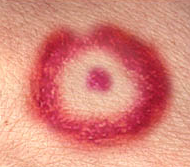Residents, experts share tips for preventing Lyme Disease in neighborhood parks

The growing amount of cases for Lyme disease has raised concern from people living near parks in Northeast Philadelphia.
Lyme disease is the most common vector-borne disease in the United States. Lyme Disease,which is bacterial, can cause serious physical problems, and if left untreated, can cause long-term health issues.
Holmesburg resident Bob Beaderman frequently walks his dog in Pennypack Park, and caught Lyme Disease a few years ago. Luckily, Beaderman received testing from his doctor before becoming ill.
“I’ve read up many times of ticks and Lyme Disease for years because I like to go to the park and I found a tick on me one day, went to the doctor, and sure enough, was tested positive for Lyme Disease. I was put on antibiotics before the red bull’s eye mark appeared on my skin,” Beaderman said.

One of the first symptoms of Lyme Disease is a spreading rash, typically where the tick bite occurred, and takes one to two weeks to be detected after the disease has been transmitted. Ticks will attach anywhere on the body, but prefer body creases such as the armpit, groin, back of the knee, and nape of the neck; rashes will therefore often appear in these areas.
“Usually, people will get symptoms of joint pains, fatigue, severe headaches and arthritis,” Beaderman explained. “But since I found mine out earlier, I was able to avoid that mess with antibiotics.”
Alan Kaminsky of Friends of Pennypack Park said he believes the warm winter will result in a greater amount of Lyme Disease cases this year. “Spring through the Fall months are the most active time for ticks,” he said. “Usually there is a time where they die down, but the winter was so mild this year, they had time to regenerate within the parks.”
Residents living around parks are susceptible to ticks because of the climate within the parks. “Deer ticks like cool, moist places like grassy areas at the edge of the woods or along roads and paths or around shrubs,” Kaminsky said. “Obviously, people should avoid sitting down in these areas or touching any shrubs or trees.”
A 2009 chart of infectious disease from the Center For Disease Control and Prevention statistics showed more than 5,000 cases of Lyme Disease in Pennsylvania. This number is more than the amount of cases for HIV and Hepatitis (A, B, and C) combined.
Because the Northeast has so many parks, residents are especially susceptible.
Tom Witmer, director of natural resources for Philadelphia Parks and Recreation, said people often do not notice the heavy deer population within the area, meaning the deer-borne ticks go unnoticed in the community.
“What we have is more and more deer populating the area, and more deer-borne ticks spreading in the parks,” Witmer said. “The difficult part is finding a solution, because these parks are surrounded with residential living space. We can’t just go in and kill the deer.” Witmer also said that once or twice a year, the Fairmount Park System will make a call to hunters to go into the parks and combat the deer to cut down on over-population, but not in residential park areas.
According to the American Lyme Disease Foundation, one of the best ways to prevent tick bites is to stay on clear trail paths.
When she takes morning walks in Pennypack Park, Barbara Feiber makes sure to cover her skin and wear light-colored clothing. “Ticks are easier to see if I am wearing brighter colors, and I always wear a hat and check my body afterwards,” Feiber said. “You really have to watch out, because they’ll get you.”
The Lyme Disease Association of Southeastern Pennsylvania website gives information on how to check yourself when you get home from the park. Upon returning home, spin your clothes in the dryer for 20 minutes to kill any unseen ticks. The site also points out that a shower and shampoo may help remove crawling ticks. Because ticks can be the size of poppy seeds, it is important to inspect places where they may not be visible, such as hair and armpits.
If a tick is found on the body, chances of catching Lyme Disease are greatly reduced if the tick is removed within 48 hours.
“With all of these ticks spreading in the parks,” Feiber said, “learning ways of preventing Lyme Disease is helpful for people who live close to the parks and people can enjoy these wonderful parks without worrying about being covered in ticks.”
Matthew Flowers is a student reporting for Philadelphia Neighborhoods, the publication of Temple University’s Multimedia Urban Reporting Lab.
WHYY is your source for fact-based, in-depth journalism and information. As a nonprofit organization, we rely on financial support from readers like you. Please give today.



